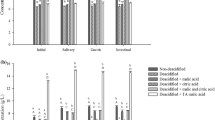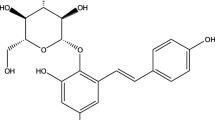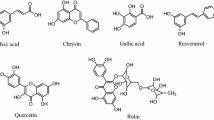Abstract
Purpose. To evaluate the effects of fresh lime, lemon, grapefruit, and pummelo juices on the transport of digoxin, a P-glycoprotein (P-gp) substrate, in Caco-2 cell monolayers.
Methods. Bidirectional [3H]-digoxin fluxes across confluent Caco-2 cell monolayers were determined in 0-50% fruit juices at pH 7.4. Verapamil HCl (100 μM) served as positive control. Juice toxicity was evaluated by the 3-(4,5 dimethylthiazolyl-2)-2,5-diphenyl- tetrazolium bromide assay.
Results. Apical-to-basal (A-to-B) digoxin flux was enhanced by 50% fruit juice in the order of lemon > lime > pummelo > grapefruit. The four fruit juices could be divided into two groups based on their effects on transepithelial electrical resistance (TEER), viability, and digoxin transport activity of the Caco-2 cells. Grapefruit and pummelo juices produced similar digoxin transport profiles that were characteristic of those observed with P-gp inhibitors. Both juices decreased net digoxin efflux by 1.2 U per 10% increase in juice concentration and had a propensity to increase cellular TEER at high concentrations (>30%). However, cellular TEER and viability decreased with increasing concentration of lime and lemon juices. Both juices also produced similar digoxin transport profiles, the A-to-B and B-to-A digoxin Papp increasing with increasing juice concentration above 5%. Net digoxin efflux was 30% of control value and relatively independent of juice concentration. These results paralleled the groupings of the four fruits according to their prominent flavonoid pattern and taxonomy.
Conclusion. The effects of lime, lemon, grapefruit, and pummelo juices on the TEER, viability, and digoxin transport activity of the Caco-2 cells appeared to be dependent on the dominant flavonoid pattern and taxonomy of the citrus fruits.
Similar content being viewed by others
REFERENCES
D. G. Bailey, J. D. Spence, C. Munoz, and J. M. O. Arnold. Interaction of citrus juices with felodipine and nifedipine. Lancet 337:268-269 (1991).
G. C. Kane and J. J. Lipsky. Drug-grapefruit juice interactions. Mayo Clin. Proc. 75:933-942 (2000).
D. G. Bailey, J. M. O. Arnold, C. Munoz, and J. D. Spence. Grapefruit juice-felodipine interaction: mechanism, predictability, and effect of naringin. Clin. Pharmacol. Ther. 53:637-642 (1993).
K. S. Lown, D. G. Bailey, R. J. Fontana, S. K. Janardan, C. H. Adair, L. A. Fortlage, M. B. Brown, W. Guo, and P. B. Watkins. Grapefruit juice increases felodipine oral availability in humans by decreasing intestinal CYP3A4 protein expression. J. Clin. Invest. 99:2545-2553 (1997).
D. J. Edwards, M. E. Fitzsimmons, E. G. Schuetz, K. Yasuda, M. P. Ducharme, L. H. Warbasse, P. M. Woster, J. D. Schuetz, and P. Watkins. 6′,7′-Dihydroxybergamottin in grapefruit juice and Seville orange: effects on cyclosporine disposition, enterocyte CYP3A4, and P-glycoprotein. Clin. Pharmacol. Ther. 65:237-244 (1999).
L.-Q. Guo, K. Fukuda, T. Ohta, and Y. Yamazoe. Role of furanocoumarin derivatives on grapefruit juice-mediated inhibition of human CYP3A4 activity. Drug Metab. Dispos. 28:766-771 (2000).
A. Ohnishi, H. Matsuo, S. Yamada, H. Takanaga, S. Morimoto, Y. Shoyama, H. Ohtani, and Y. Sawada. Effect of furanocoumarin derivatives in grapefruit juice on the uptake of vinblastine by Caco-2 cells and on the activity of cytochrome P450 3A4. Br. J. Clin. Pharmacol. 130:1369-1377 (2000).
H. Spahn-Langguth and P. Langguth. Grapefruit juice enhances intestinal absorption of the P-glycoprotein substrate talinolol. Eur. J. Pharm. Sci. 12:361-367 (2001).
E.-J. Wang, C. N. Casciano, R. P. Clement, and W. W. Johnson. Inhibition of P-glycoprotein transport function by grapefruit juice psoralen. Pharm. Res. 18:432-438 (2001).
H. Takanaga, A. Ohnishi, H. Matsuo, and Y. Sawada. Inhibition of vinblastine efflux mediated by P-glycoprotein by grapefruit juice components in Caco-2 cells. Biol. Pharm. Bull. 21:1062-1066 (1998).
T. Ikegawa, F. Ushigome, N. Koyabu, S. Morimoto, Y. Shoyama, M. Naito, T. Tsuruo, H. Ohtani, and Y. Sawada. Inhibition of P-glycoprotein by orange juice components, polymethoxyflavones in adriamycin-resistant human myelogenous leukemia (K562/ADM) cells. Cancer Lett. 160:21-28 (2000).
H. Takanaga, A. Ohnishi, S. Yamada, H. Matsuo, S. Morimoto, Y. Shoyama, H. Ohtani, and Y. Sawada. Polymethoxylated flavones in orange juice are inhibitors of P-glycoprotein but not cytochrome P450 3A4. J. Pharmcol. Exp. Ther. 293:230-236 (2000).
Y. C. Hou, S. L. Hsiu, C. W. Tsao, Y. H. Wang, and P. D. L. Chao. Acute intoxication of cyclosporin caused by coadministration of decoctions of the fruits of Citrus aurantium and the pericarps of Citrus grandis. Planta Med. 66:653-655 (2000).
S. Kawaii, Y. Tomono, E. Katase, K. Ogawa, and M. Yano. Quantitation of flavonoid constituents in citrus fruits. J. Agric. Food Chem. 47:3565-3571 (1999).
U. Justesen, P. Knuthsen, and T. Leth. Quantitative analysis of flavonols, flavones and flavanones in fruits, vegetables and beverages by high-performance liquid chromatography with photo-diode array and mass spectrometric detection. J. Chromatogr. A 799:101-110 (1998).
M. C. de Castillo, C. G. de Allori, R. C. de Gutierrez, O. A. de Saab, N. P. de Fernandez, C. S. de Ruiz, A. P. Holgado, and O. M. de Nader. Bactericidal activity of lemon juice and lemon derivatives against Vibrio cholerae. Biol. Pharm. Bull. 23:1235-1238 (2000).
S. Ogata, Y. Miyake, K. Yamamoto, K. Okumura, and H. Taguchi. Apoptosis induced by the flavonoid from lemon fruit (Citrus limon BURM. f.) and its metabolites in HL-60 cells. Biosci. Biotechnol. Biochem. 64:1075-1078 (2000).
M. Gharagozloo and A. Ghaderi. Immunomodulatory effect of concentrated lime juice extract on activated human mononuclear cells. J. Ethnopharmacol. 77:85-90 (2001).
B. Greiner, M. Eichelbaum, P. Fritz, H. P. Kreichgauer, O. von Richter, J. Zundler, and H. K. Kroemer. The role of intestinal P-glycoprotein in the interaction of digoxin and rifampin. J. Clin. Invest. 104:147-153 (1999).
C. Pauli-Magnus, O. von Richter, O. Burk, A. Ziegler, T. Mettang, M. Eichelbaum, and M. F. Fromm. Characterization of the major metabolites of verapamil as substrates and inhibitors of P-glycoprotein. J. Pharmacol. Exp. Ther. 293:376-382 (2000).
D. A. Scudiero, R. H. Shoemaker, K. D. Paull, A. Monks, S. Tierney, T. H. Nofziger, M. J. Currens, D. Seniff, and M. R. Boyd. Evaluation of a soluble tetrazolium/formazan assay for cell growth and drug sensitivity in culture using human and other tumor cell lines. Cancer Res. 48:4827-4833 (1988).
M. E. Cavet, M. West, and N. L. Simmons. Transport and epithelial secretion of the cardiac glycoside, digoxin, by human intestinal epithelial (Caco-2) cells. Br. J. Pharmacol. 118:1389-1396 (1996).
I. A. de Lannoy and M. Silverman. The MDR1 gene product, P-glycoprotein, mediates the transport of the cardiac glycoside, digoxin. Biochem. Biophys. Res. Commun. 189:551-557 (1992).
R. H. Stephens, C. A. O'Neill, A. Warhurst, G. L. Carlson, M. Rowland, and G. Warhurst. Kinetic profiling of P-glycoprotein-mediated drug efflux in rat and human intestinal epithelia. J. Pharmacol. Exp. Ther. 296:584-591 (2001).
M. Berhow, B. Tisserat, K. Kanes, and C. Vandercook. Survey of phenolic compounds produced in Citrus. Technical Bulletin Number 1856, Agricultural Research Service, United States Department of Agriculture, 1998.
H. C. Barrett and A. M. Rhodes. A numerical taxonomic study of affinity relationships in cultivated Citrus and its close relatives. Syst. Bot. 1:105-136 (1976).
R. Tian, N. Koyabu, H. Takanaga, H. Matsuo, H. Ohtani, and Y. Sawada. Effects of grapefruit juice and orange juice on the intestinal efflux of P-glycoprotein substrates. Pharm. Res. 19:802-809 (2002).
Author information
Authors and Affiliations
Corresponding author
Rights and permissions
About this article
Cite this article
Xu, J., Go, M.L. & Lim, LY. Modulation of Digoxin Transport Across Caco-2 Cell Monolayers by Citrus Fruit Juices: Lime, Lemon, Grapefruit, and Pummelo. Pharm Res 20, 169–176 (2003). https://doi.org/10.1023/A:1022254617664
Issue Date:
DOI: https://doi.org/10.1023/A:1022254617664




